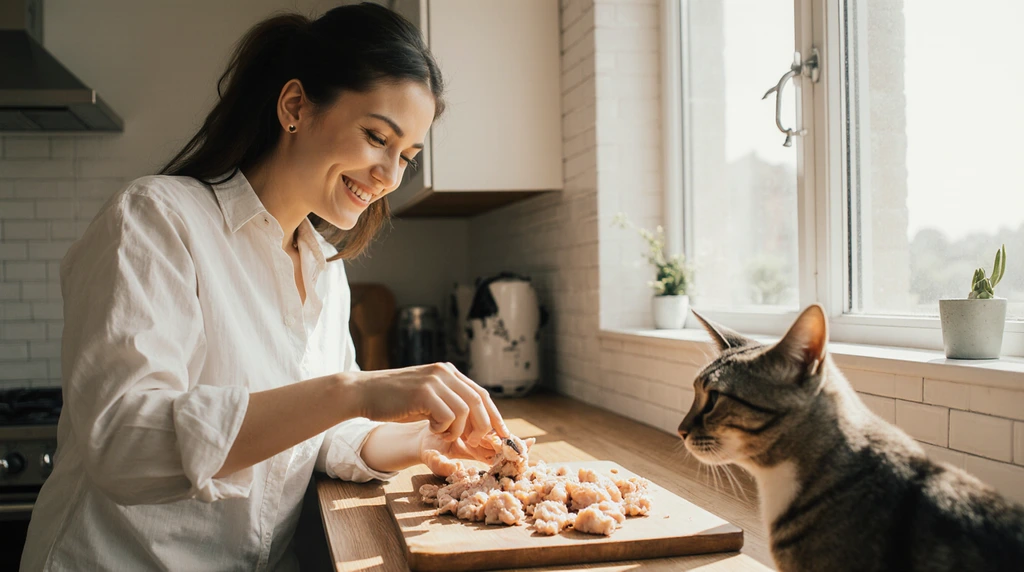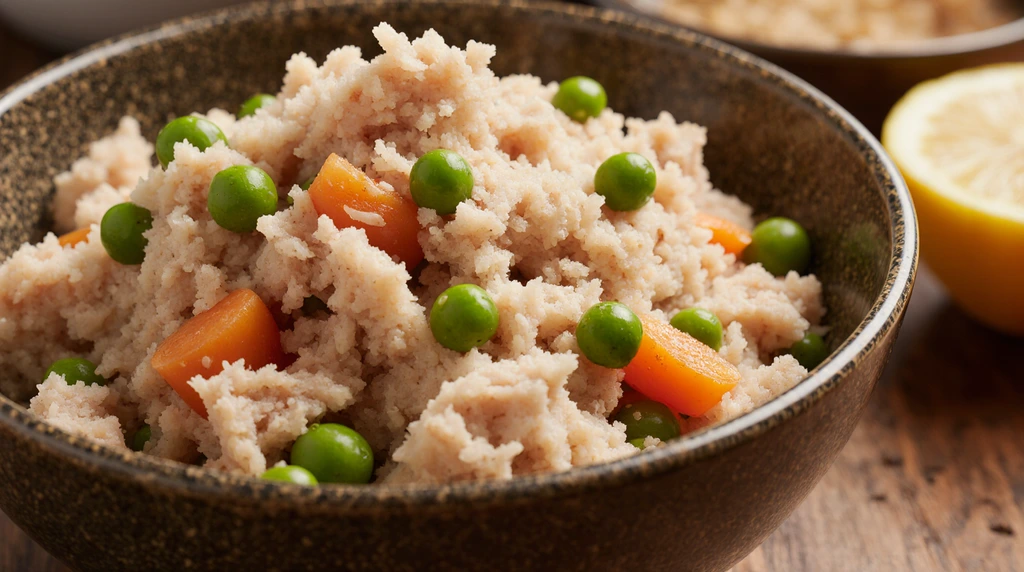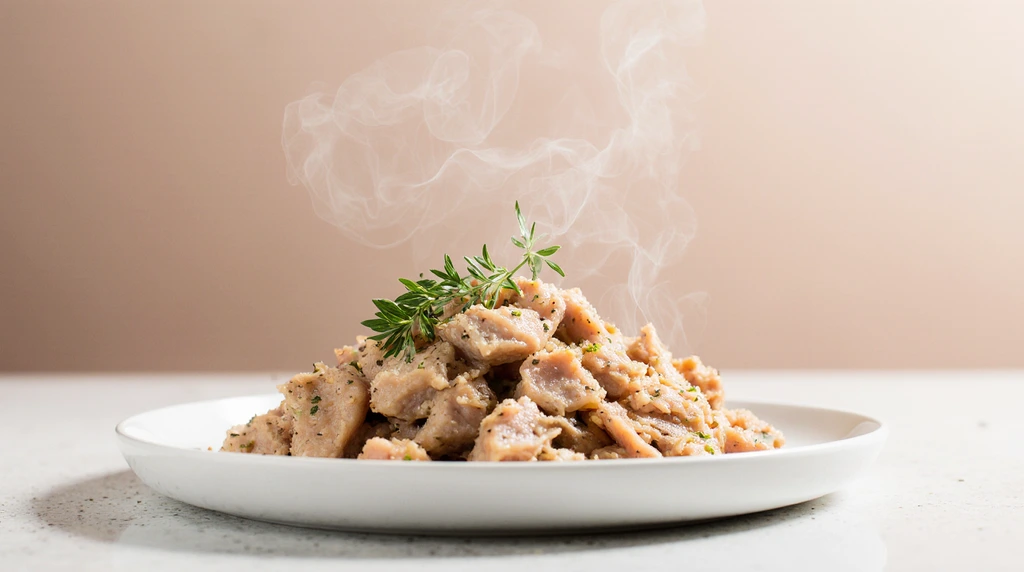Introduction:
Why Homemade Chicken Might Be the Best Thing You Cook All Week — and Not for You
Let’s be honest — if you’re Googling “chicken recipe for cats,” you’ve probably had that moment: your cat sniffs their bowl, gives you the look, and walks away like you’ve offended their royal sensibilities. And maybe, deep down, you’re wondering if what’s in that kibble bag is really doing them any good.
Here’s the truth: cats are obligate carnivores. They don’t need fillers, by-products, or synthetic flavors. What they crave — and actually thrive on — is real meat, especially lean, protein-packed options like chicken. But here’s where things get tricky: not all “chicken” is created equal, and feeding your feline homemade meals isn’t just about tossing them some leftover rotisserie.
That’s why this guide exists. Whether your cat’s been turning up their nose at store-bought food, dealing with allergies, or you simply want more control over what they eat, this article will walk you through how to prepare chicken at home safely, deliciously, and with vet-informed guidelines in mind.
By the end, you’ll not only have a recipe or two to try — you’ll understand exactly how to make real food work with your cat’s nutritional needs, not against them.
Table of Contents
Ingredients List for a Basic Chicken Cat Recipe

Before we dive into cooking, let’s get one thing straight: when it comes to feeding cats, less is more. No salt, no spices, no oils — just clean, high-quality ingredients that support their biology, not ours.chicken recipe for cats.
Here’s what you’ll need for a safe, simple homemade chicken recipe for cats:
Essential Ingredients:
- 1 boneless, skinless chicken breast (organic or free-range preferred)
- 2 tbsp water or unsalted bone broth (optional: for moisture and flavor)
- 1/8 tsp taurine powder (optional but recommended for long-term feeding)
Optional Nutrient Add-ins:
- 1 tsp pumpkin puree (supports digestion and fiber balance)
- 1 boiled chicken heart or liver (boosts vitamins A and B, adds flavor)
- Pinch of crushed eggshell or calcium supplement (if replacing full meals)
⚠️ Always avoid: garlic, onion, salt, pepper, oil, butter, seasoning mixes, or any sauce.
Ingredient Notes:
- Chicken breast is lean and easy to digest, ideal for cats with sensitive stomachs.
- Taurine is essential for heart and eye health — cats can’t make it themselves.
- Bone broth adds moisture, which is especially helpful for cats who don’t drink much water.
- Pumpkin should be pure, not pie filling (no sugar or spices).
What if I don’t have taurine or pumpkin?
Don’t worry — this base recipe works fine as an occasional meal or treat without supplements. Just don’t use it as your cat’s full-time diet unless it’s nutritionally balanced and approved by a vet.
How to Cook Chicken for Cats (Step-by-Step Guide)chicken recipe for cats.
Cooking for your cat might feel intimidating at first — especially with all the “don’ts” floating around online. But once you try it, you’ll realize it’s shockingly simple… and maybe even therapeutic. Here’s how to make a clean, cat-safe chicken dish that feels more like love than labor.
Step 1: Boil the Chicken Safely
- Place the boneless, skinless chicken breast into a small pot.
- Add enough plain water to fully submerge the meat.
- Cover and bring to a gentle boil over medium heat.
- Once boiling, reduce to a simmer and cook for 12–15 minutes, or until the center is fully white — no pink.
👀 Tip: Want more flavor and moisture? You can substitute half the water with unsalted bone broth — just double-check there are zero added seasonings.
Step 2: Cool and Shred
- Remove chicken from the pot and let it rest on a clean plate for 5–10 minutes.
- Once cool enough to touch, use clean hands or a fork to shred the chicken into bite-sized flakes.
- Discard any hard or stringy bits — especially tendons or gristle.
Step 3: Add Optional Enhancements
- If you’re using taurine powder, sprinkle it over the shredded meat now (while it’s warm but not hot).
- Mix in optional ingredients like pumpkin puree, liver bits, or a splash of cooled broth.
- Stir gently to combine.
Step 4: Serve (or Store)
- Offer a small portion (1–2 tbsp) to your cat at room temperature.
- Store the rest in an airtight glass container in the fridge for up to 3 days.
- For longer storage, freeze portions in silicone molds or ice cube trays.
Can I just give my cat plain chicken?
Yes — plain, unseasoned boiled chicken is perfectly fine as an occasional treat or supplemental protein. Just don’t rely on it as your cat’s sole diet unless it’s been fortified and approved by a vet. Chicken alone lacks essential nutrients like taurine, calcium, and certain fatty acids.

Tips for Serving Chicken to Cats (Without Overdoing It) chicken recipe for cats.
So you’ve cooked up the chicken, it smells great (yes, even to you), and your cat is circling like a little shark. Before you scoop a handful into their bowl, let’s hit pause. Because how you serve it matters just as much as what you serve.
Here’s how to do it right — with your cat’s long-term health in mind.
Start Small and Observe
- Begin with 1 to 2 tablespoons of shredded chicken mixed into their usual food.
- Watch for changes in digestion: softer stools, vomiting, or signs of allergies (like itching).
- If all’s well after a few tries, you can increase gradually — but chicken should never exceed 10–20% of the daily diet unless it’s vet-formulated.
Bonus Tip: Use Leftovers Wisely
- Freeze leftover chicken in bite-sized cubes for future use — they defrost fast and double as a hydration boost.
- Add a spoonful of cooled boiling water or bone broth over dry food to tempt picky eaters.
Feeding Frequency & Portioning
| Cat Weight | Max Chicken Portion (Per Day) |
|---|---|
| Under 6 lbs | 1–1.5 tbsp |
| 6–10 lbs | 2–3 tbsp |
| 10–15 lbs | 3–4 tbsp |
⚠️ Remember: this is based on a supplemental treat or topper. If you plan to go fully homemade, a balanced recipe with supplements is non-negotiable.
Can chicken become a daily part of my cat’s meals?
Yes, but only as a supplement to a complete diet — or as part of a fully balanced homemade plan (with supplements like taurine, calcium, and vitamin E). Think of chicken like a healthy side dish: great often, but not meant to replace the main course unless it’s nutritionally fortified.
Recipe Variations and Add-Ins (Boost Flavor and Nutrition)
Not every cat has the same tastes. Some love the simplicity of plain chicken, others turn their nose up unless it’s got a little “something extra.” Good news: you can absolutely get creative — safely. Here are ways to level up your chicken cat recipes without crossing into risky territory.
1. Chicken Broth Soup for Hydration (chicken recipe for cats)
Perfect for cats who don’t drink enough water:
- Combine 2 tbsp shredded chicken with 2–3 tbsp unsalted bone broth (cooled).
- Serve as a warm soup or chilled treat.
- Optional: stir in a pinch of gelatin powder for texture and joint support.
Why it works: Moisture-rich, easy to lap up, and can support kidney health if used occasionally.
2. Chicken & Pumpkin Puree (Digestive Support)(chicken recipe for cats)
Best for cats with constipation, hairballs, or sensitive digestion:
- Mix 1 tbsp shredded chicken with 1 tsp pure canned pumpkin (no spice!).
- Optional: a drop of salmon oil or omega-3 supplement.
Why it works: Pumpkin adds fiber without carbs, and the smooth texture is easy on older or dental-challenged cats.
3. Organs & Extras (High-Nutrient Boost)(chicken recipe for cats)
For cats needing extra nutrition or recovering from illness:
- Add 1 tsp chopped chicken liver or boiled heart to the chicken base.
- Mix with broth and cool before serving.
Why it works: Organ meats are nature’s multivitamins — rich in taurine, B12, and iron — but use sparingly (no more than 10% of the mix).
Caution on Raw Diet Add-Ins
You might see raw chicken or organs recommended online, but feeding raw safely is a whole system — not just uncooked meat in a bowl. If you’re considering raw, talk to your vet or a feline nutritionist first. Bacterial risk and nutrient imbalance are real concerns.
Are mix-ins like rice or veggies OK for cats?
Generally, no. Cats don’t process grains or most vegetables well, and they derive zero essential nutrients from carbs. While a bit of rice won’t hurt in a pinch, it offers nothing your cat needs — and could displace the protein they do. Stick to meat, broth, and feline-safe add-ins.
What to Avoid When Cooking Chicken for Cats (chicken recipe for cats)
Cooking for your cat can feel empowering — but here’s the trap: just because an ingredient is “natural” or “human-grade” doesn’t mean it’s cat-safe. In fact, a lot of common cooking habits can be downright dangerous for your feline.
Here’s a no-nonsense list of things to never include in your homemade chicken recipes for cats — no matter how harmless they seem.
Forbidden Ingredients (Even in Small Amounts)
- Onions & Garlic (raw, cooked, powdered — all toxic)
- Salt & Seasonings (cats’ kidneys can’t handle it)
- Butter or Cooking Oil (unnecessary fat, risk of diarrhea)
- Pepper, Paprika, or Spices (can irritate their GI tract)
- Soy Sauce or Broth Cubes (extremely high in sodium)
- Gravy or Human Sauces (often contains dairy, gluten, or thickening agents)
⚠️ Even one bite of onion or garlic can lead to Heinz body anemia — a dangerous condition that damages red blood cells.
Unsafe Cooking Practices
- Grilled or Fried Chicken: too oily, potentially carcinogenic char
- Bones or Bone Fragments: cooked bones can splinter and cause choking or internal injury
- Leftovers from Your Plate: they usually contain seasoning, sauces, or hidden allergens
Surprising “Health” Foods That Aren’t Cat-Friendly
- Dairy: most cats are lactose intolerant — milk, cheese, cream = upset stomach
- Grains (rice, oats, corn): not toxic, but nutritionally useless
- Raw Egg White: contains avidin, which blocks biotin absorption
- Canned Tuna: often too salty and not balanced for cats
Why can’t cats eat what we eat?
Because cats are obligate carnivores — they evolved to eat prey, not pasta. Their bodies aren’t built to digest many of the things humans enjoy. So while that garlic-seasoned rotisserie chicken smells amazing to you, it could make your cat sick — or worse. Stick to simple, meat-first recipes and your cat’s body (and vet bills) will thank you.
Vet-Reviewed Nutritional Notes (Why Chicken Alone Isn’t Enough) (chicken recipe for cats)
It’s easy to assume that if chicken is safe, it must be sufficient — right? Unfortunately, that’s not the case. While chicken is a protein powerhouse, it doesn’t tick every nutritional box your cat needs. Here’s what vets and feline nutritionists want you to understand before making homemade food a regular thing.
The Good: What Chicken Offers Your Cat
- High-quality protein: supports muscle, metabolism, and immune function.
- Low fat (especially breast): helps manage weight and avoids GI upset.
- Easy to digest: ideal for sick or elderly cats needing bland meals.
- Hydration support: when served with broth, it boosts water intake.
The Gaps: What Chicken Alone Can’t Provide
Despite its benefits, plain chicken lacks several essential nutrients:
| Missing Nutrient | Why It Matters |
|---|---|
| Taurine | Prevents heart disease, blindness, and neurological decline. |
| Calcium | Balances phosphorus; needed for bones and nerves. |
| Vitamin A & D | Support skin, vision, immune system, and metabolism. |
| Essential Fatty Acids | Support brain, coat, and inflammation control. |
These nutrients must be added through organ meats, supplements, or a professionally balanced recipe. Without them, a homemade diet can lead to deficiencies in just a few weeks.
When to Use Chicken-Based Meals Long-Term (chicken recipe for cats)
You can use a homemade chicken mix as a primary food if:
- You follow a vet-formulated recipe (with taurine, vitamin and mineral additives).
- You’re rotating with a complete commercial diet or raw blend.
- Your vet has approved it for a medical reason (e.g., allergies, IBD).
Otherwise, it’s best to think of it like a multivitamin gummy: great as a boost, not enough on its own.
Do I need a supplement if I feed chicken weekly?
Yes — if chicken makes up more than 10–20% of your cat’s total weekly diet, you’ll need to add key nutrients like taurine and calcium. These aren’t optional for cats. A feline-safe multivitamin powder or raw food premix (like Alnutrin or EZComplete) can help round it out.

Frequently Asked Questions (FAQs) About Chicken Recipes for Cats (chicken recipe for cats)
Even if you’ve read every label, boiled every piece just right, and triple-checked the ingredients — doubts still creep in. That’s normal. Below are some of the most common (and most important) questions cat parents ask when preparing homemade chicken meals.
Can I feed my cat cooked chicken every day? (chicken recipe for cats)
Yes — but only if it’s part of a nutritionally balanced plan. Plain cooked chicken can be a regular protein source if you add taurine, calcium, essential vitamins, and fatty acids. Without these, daily feeding risks malnutrition. For most pet parents, it’s safer to use chicken as a topper or treat, not the main course.
Is raw chicken better than cooked? (chicken recipe for cats)
Not necessarily. Raw diets can offer benefits, but they require strict handling, proper balance, and often a vet’s guidance. Raw chicken carries bacterial risks (like salmonella or campylobacter) and shouldn’t be served without a carefully designed raw feeding plan. If you’re not experienced with raw feeding, stick with cooked.
Can I mix shredded chicken with dry cat food? (chicken recipe for cats)
Absolutely. It’s one of the easiest ways to boost moisture and protein in your cat’s meal. Just make sure the chicken is plain, unseasoned, and cooled. A tablespoon mixed into kibble can also encourage picky eaters to finish their bowl.
How much chicken is too much? (chicken recipe for cats)
If more than 20% of your cat’s total diet comes from plain chicken, you’re likely entering nutrient deficiency territory — unless supplements are added. For most adult cats, that’s no more than 2–4 tablespoons per day depending on body weight. When in doubt, ask your vet or track portions over a week.
What if my cat doesn’t like it? (chicken recipe for cats)
Don’t panic. Some cats just aren’t into bland meat — or they associate chicken with past medical diets. Try warming the chicken slightly (to release aroma), mixing it with broth, or offering it as a treat instead of a full meal. And hey, some cats are just… tuna people.
